
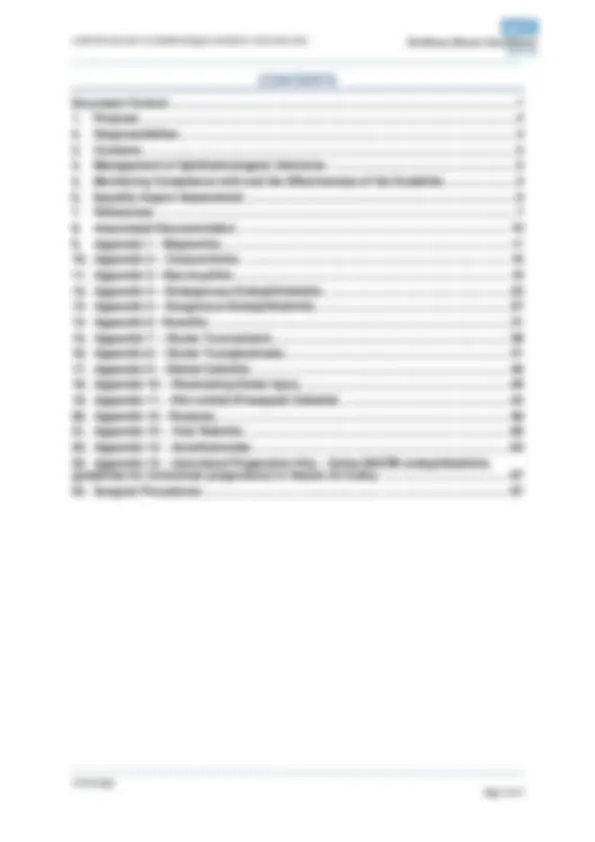









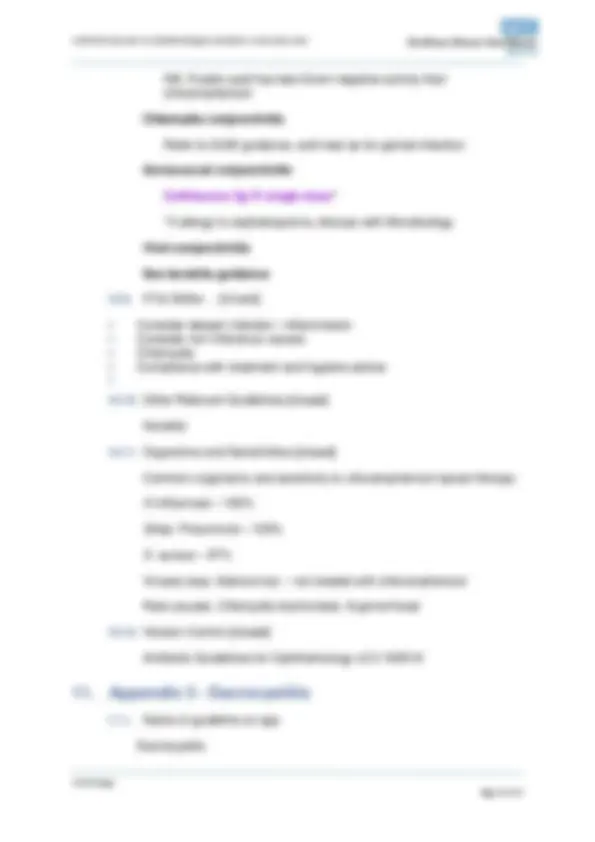
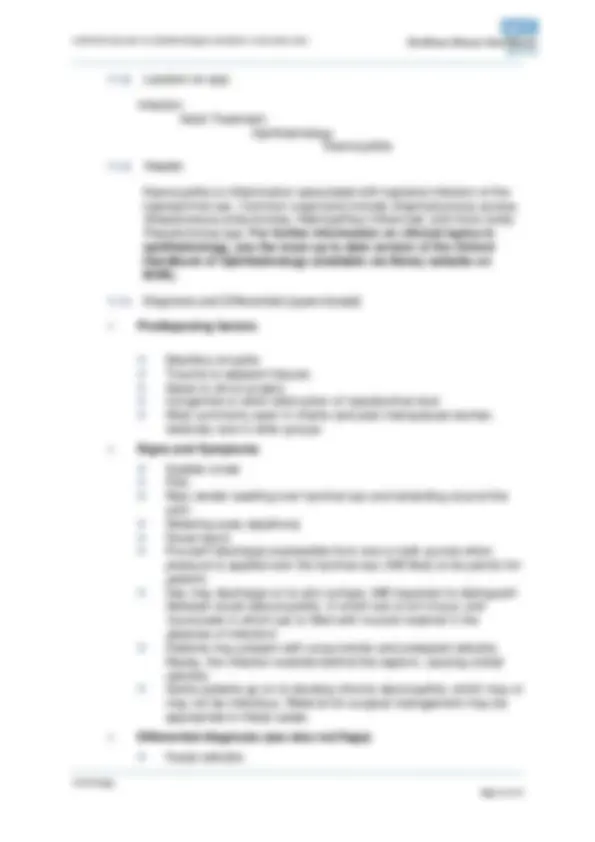



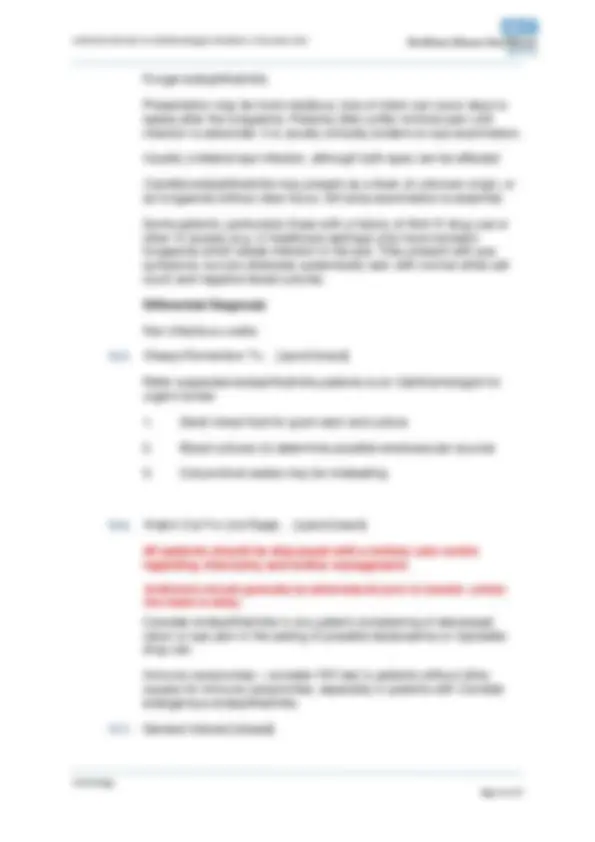















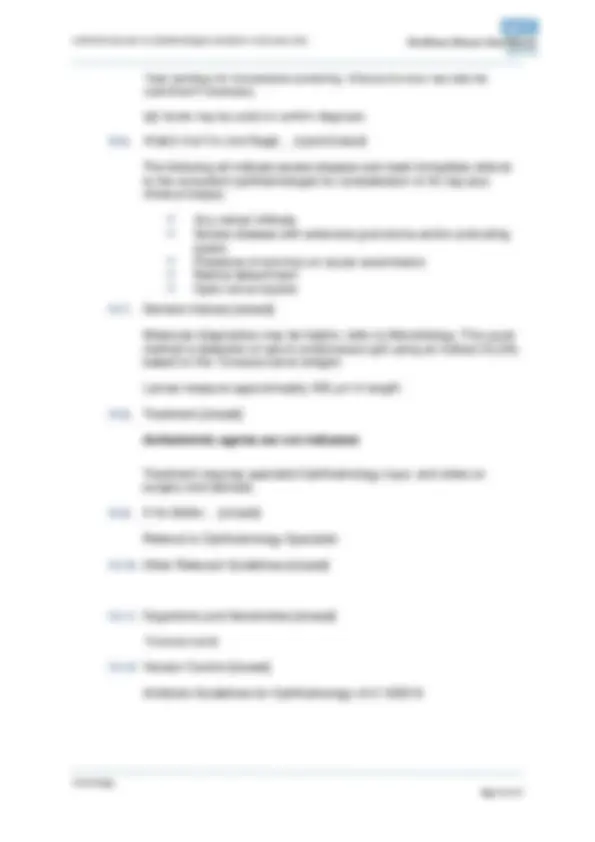





























Study with the several resources on Docsity

Earn points by helping other students or get them with a premium plan


Prepare for your exams
Study with the several resources on Docsity

Earn points to download
Earn points by helping other students or get them with a premium plan
Community
Ask the community for help and clear up your study doubts
Discover the best universities in your country according to Docsity users
Free resources
Download our free guides on studying techniques, anxiety management strategies, and thesis advice from Docsity tutors
Antibiotic guidelines for various ophthalmological indications in secondary care settings. It covers symptoms, diagnosis, and treatment for different types of eye infections, including blepharitis, conjunctivitis, keratitis, and endophthalmitis. The guidelines also include information on version control, other relevant guidelines, and risk factors for developing infections.
What you will learn
Typology: Lecture notes
1 / 67

This page cannot be seen from the preview
Don't miss anything!




























































Microbiology
Title
Author Author’s job title Consultant Microbiologist Consultant Ophthalmologist Pharmacist Directorate Diagnostics
Department Microbiology Version Date Issued Status^ Comment / Changes / Approval 0.1 Jan 2011
Draft First draft for consultation. After discussion with Mr Nestel. Further discussion with Ophthalmology. Changes to prophylaxis after penetrating injury. Changes to keratitis. Change to prophylaxis for globe injury 1.0 Sep 2011
Final Approved by DTG with minor amendments.
Revision Minor amendments to document control report, hyperlinks to appendices, and added headers and footers. Automatic table of contents. Change of co-amoxiclav frequency for pre-orbital cellulitis. 1.3 Jan 2012
Revision Corrected hyperlinks to Vancomycin guideline in appendices. 1.4 Feb 2012
Revision Change from cefuroxime to cefotaxime for orbital cellulitis to bring into line with published guidance. 2.0 Mar 2012
Final Approved by Drug and Therapeutics Committee on 8th March 2012 with minor amendments. 2.1 Jun 2012
Revision Minor amendment by Corporate Governance to document control report. 2.2 Nov 2012
Revision Minor changes to preparations (preservative free) and dosing intervals for keratitis 2.3 Mar 2013
Revision Keratitis – changed to preservative free drops.
2.4 Jun 2017
Revision Guidance split into two: treatment and surgical prophylaxis. Added acanthamoeba guidance. 3.0 May 2019
Final Reviewed with Consultant Ophthalmologist. Information for intra-vitreal preparations deleted, to refer to on-site manual in theatres. Anti-fungal guidance added for keratitis, endophthalmitis, penetrating globe injury. Clinical diagnostics information added for all indications as per updated NICE requirements for antibiotic guidelines. References updated. Approved at DTC 16th^ May 2019. Main Contact Consultant Microbiologist Microbiology North Devon District Hospital Raleigh Park Barnstaple, EX31 4JB
Tel: Direct Dial – Tel: Internal – Email :
Microbiology
Lead Director Director of Medicine Superseded Documents Antibiotic Guidelines for Ophthalmology v1.8 290413 Issue Date May 2019
Review Date May 2022
Review Cycle Three years Consulted with the following stakeholders:
Antibiotic Working Group Drug & Therapeutics Group Consultant Ophthalmologists
Approval and Review Process Antibiotic Working Group Drug & Therapeutics Group
Local Archive Reference G:\ANTIBIOTICSTEWARDSHIP Local Path G:\ANTIBIOTIC STEWARDSHIP\Stewardship\Antibiotic policies\Published policies Filename Antibiotic Guidelines for Ophthalmology v2.0 160519 Policy categories for Trust’s internal website (Bob) Pharmacy, Microbiology, Ophthalmology
Tags for Trust’s internal website (Bob) Conjunctivitis, Pre-orbital cellulitis, Orbital cellulitis, Endogenous endophthalmitis, Exogenous endophthalmitis, Keratitis, Viral retinitis, Rosacea, Dacrocystitis, Blepharitis, Toxoplasmosis, Toxocariasis, Surgical prophylaxis
Microbiology
1.1. This document sets out Northern Devon Healthcare NHS Trust’s best practice guidelines for appropriate microbiological investigation and antimicrobial prescribing in adult patients with Ophthalmological infection.
1.2. This guideline applies to all adults and must be adhered to. Special considerations exist for pregnant and breastfeeding patients; liaise with specialist clinicians as appropriate in these cases. See separate guidance for paediatric patients.
1.3. Non-compliance with this guideline may be for valid clinical reasons only. The reason(s) for non-compliance must be documented clearly in the patient’s notes.
1.4. This guideline is primarily aimed at all prescribing teams but other staff (e.g. nursing staff, pharmacists) may need to familiarise themselves with some aspects of the guideline.
1.5. Implementation of this guideline will ensure that:
Ophthalmological infection is managed according to current evidence and standards of practice in the wider healthcare community. A standard of care is specified to facilitate a consistent approach between ophthalmology, microbiology and pharmacy in terms of patient management, specimen processing and drug availability.
2.1. Responsibility for education and training lies with the Lead Consultant Microbiologist for Antibiotic Stewardship. It will be provided through formal study days and informal training on the ward.
2.2. The author will be responsible for ensuring the guidelines are reviewed and revisions approved by the Drug and Therapeutics Group in accordance with the Document Control Report.
2.3. All versions of these guidelines will be archived in electronic format by the author within the Antibiotic Stewardship policy archive.
2.4. Any revisions to the final document will be recorded on the Document Control Report.
2.5. To obtain a copy of the archived guidelines, contact should be made with the author.
2.6. Monitoring of implementation, effectiveness and compliance with these guidelines will be the responsibility of the Lead Clinician for Antibiotic Stewardship. Where non-compliance is found, the reasons for this must have been documented in the patient’s medical notes.
Microbiology
2.7. The AWG is responsible for:
Leading antibiotic guideline development and review within Northern Devon Healthcare Trust Involving all relevant stakeholders in guideline development and review
3.1. Contact numbers:
Microbiologist Bleep 193. Via switchboard out of hours. Antibiotic Pharmacist Bleep 029 (Mon-Fri only) On call Ophthalmologist Via switchboard out of hours.
4.1. See appendices
5.1. The following could be used:
Required specimens to be sent as per guideline 100% Antibiotic (topical and systemic) used as per guideline or microbiology advice 100%
5.2. Incidents involving ophthalmic infection should be reported according to the Trust’s Incident Reporting Policy. Critical incident reports relating to ophthalmologic infection will be collated by the Antibiotic Pharmacist. Results will be reported on an annual basis to the Drug and Therapeutics Group.
Microbiology
7.1. General
Denniston and Murray [Eds.]. 2018. 4th^ Edition Oxford Handbook of Ophthalmology. Via Trust intranet. http://oxfordmedicine.com/view/10.1093/med/9780198804550.001.0001/med- 9780198804550
Clinical guidelines for Consultant Ophthalmologists – department utilises this reference source as their gold standard
7.2. Conjunctivitis
Clinical Knowledge Summary. Infective Conjuncitivitis. https://cks.nice.org.uk/conjunctivitis-infective Last revised August 2015. Accessed 6/6/
The College of Optometrists. Clinical Management Guideline: Conjunctivitis. https://www.college-optometrists.org/guidance/clinical-management- guidelines/conjunctivitis-bacterial-.html Last reviewed June 2014. Accessed 6/6/17.
7.3. Peri- and orbital cellulitis
Papier A, Tuttle DJ, Mahar TJ. Differential diagnosis of the swollen red eyelid. Am Fam Physician. 2007 76(12):1815-24.
Spellberg B, et al. Recent advances in the management of mucormycosis: from bench to bedside. Clin Infect Dis. 2009 Jun 15;48(12):1743-
The College of Optometrists. 2015. Cellulitis, preseptal and orbital
7.4. Endophthalmitis
Riddell J 4th, Comer GM, Kauffman CA. (2011) Treatment of endogenous fungal endophthalmitis: focus on new antifungal agents. Clin Infect Dis.52, 648-53.
7.5. Keratitis
M Daniell. Overview: Initial antimicrobial therapy for microbial keratitis Br J Ophthalmol. 2003 September; 87(9): 1172– 1174
The Ofloxacin Study Group. Ofloxacin monotherapy for the primary treatment of microbial keratitis: a double-masked, randomized, controlled trial with conventional dual therapy. Ophthalmology. 1997 Nov;104(11):1902-9.
Wilhelmus K. 2009. Therapeutic interventions for HSV epithelial keratitis. Cochrane Rev.
Microbiology
The College of Optometrists. 2016. Clinical Guideline: Microbial keratitis (bacterial, fungal) v.10. https://www.college-optometrists.org/guidance/clinical- management-guidelines/microbial-keratitis-bacterial-fungal-.html
The College of Optometrists. 2015. Clinical Guideline: Keratitis (marginal) v.9. https://www.college-optometrists.org/guidance/clinical-management- guidelines/keratitis-marginal-.html
The College of Optometrists. 2016. Clinical Guideline: Herpes Simplex Keratitis v.11. https://www.college-optometrists.org/guidance/clinical- management-guidelines/herpes-simplex-keratitis-hsk-.html
The College of Optometrists. 2015. Clinical Guideline: Microbial Keratitis (Acanthameoba Sp.) v.10. https://www.college- optometrists.org/guidance/clinical-management-guidelines/microbial-keratitis- acanthamoeba-sp-.html
Balderson, DE; Cai, G; Fries, MA; Kleinman, DM; McLaughlin, MM; Trivedi, TM; Wurzelmann, JI; Young, SB. 2015. A systematic review and meta- analysis to compare the efficacy of acyclovir 3% ophthalmic ointment to idoxuridine in curing herpetic keratitis by Day 7 of treatment. BMC Ophthalmology 17;15:42. doi: 10.1186/s12886-015-0022-2.
NICE. 2016. CKS Topics: Shingles. https://cks.nice.org.uk/shingles#!scenario:
7.6. Blepharitis
Clinical Knowledge Summaries. https://cks.nice.org.uk/blepharitis Last revised October 2015. Accessed 5th^ June 2017.
The College of Optometrists. Clinical Management Guidelines: Blepharitis (Lid Margin Disease). https://www.college-optometrists.org/guidance/clinical- management-guidelines/blepharitis-lid-margin-disease.html Last revised Dec
7.7. Viral retinitis
Wong R, Pavesio CE, Laidlaw DA, Williamson TH, Graham EM, Stanford MR. (2010) Acute retinal necrosis: the effects of intravitreal foscarnet and virus type on outcome. Ophthalmology. 117, 556-60.
7.8. Toxocariasis
Microbiology
SIGN. 2014. 104: Antibiotic Prophylaxis in Surgery. http://www.sign.ac.uk/assets/sign104.pdf (intracameral ceftazidime and vanc, pre and post-surgery if organic matter left)
The Royal College of Emergency Medicine. 2017. Best Practice Guideline: Pharmacological Agents for Procedural Sedation and Analgesia in the Emergency Department. http://www.rcem.ac.uk/docs/College%20Guidelines/Pharmacological%20Age nts%20for%20Procedural%20Sedation%20and%20Analgesia%20(Jan% 17%20Revised).pdf (ketamine contraindicated for globe injury)
Wilson, A; Soar, J. 2000. ANAESTHESIA FOR EMERGENCY EYE SURGERY. Update in Anaesthesia 11: 46-50. http://e-safe- anaesthesia.org/e_library/06/Anaesthesia_for_emergency_eye_surgery_Upd ate_2000.pdf
7.11. Surgical prophylaxis
Sharifi E, Porco TC, Naseri A. Cost-effectiveness analysis of intracameral cefuroxime use for prophylaxis of endophthalmitis after cataract surgery. Ophthalmology. 2009 Oct;116(10):1887-
7.12. Acanthamoeba
Royal College of Optometrists. 2016. Microbial Keratitis (Acanthamoeba sp.) https://www.college-optometrists.org/guidance/clinical-management- guidelines/microbial-keratitis-acanthamoeba-sp-.html
Cochrane Eyes and Vision Group. 2015. Medical Interventions for Acanthaemoeba Keratitis. http://onlinelibrary.wiley.com/doi/10.1002/14651858.CD010792.pub2/full
Seas and Bravo. 2017. Free-living amebas and Prototheca. Uptodate.com https://www.uptodate.com/contents/free-living-amebas-and- prototheca?source=search_result&search=acanthamoeba%20keratitis&select edTitle=1~
Incident reporting policy Antibiotic guidelines for management of severe sepsis and septic shock Antibiotic prescribing policy Penicillin allergy policy Antibiotic guidelines for surgical prophylaxis
Microbiology
9.1. Name of guideline on app
Blepharitis 9.2. Location on app
Infection Adult Treatment Ophthalmology Blepharitis 9.3. Header
Anterior blepharitis primarily affects the lashes, and posterior blepharitis involves the meibomian glands. The mainstay of treatment is maintenance of good lid hygiene, even in the absence of active symptoms. For further information on clinical topics in ophthalmology, see the most up to date version of the Oxford Handbook of Ophthalmology (available via library website on BOB).
9.4. Diagnosis and Differentials [open/closed]
Predisposing factors
Dry eye disease is present in: 50% of people with staphylococcal blepharitis 25-40% of people with seborrhoeic blepharitis Patients with seborrhoeic blepharitis may also have seborrhoeic dermatitis (eg. on the scalp) A significant association has been found between Demodex mite infestation and blepharitis. Demodex folliculorum is an ectoparasite that occurs normally in the lash follicles Long-term contact lens wear Ocular rosacea (a cause of posterior marginal blepharitis)
Symptoms
Blepharitis may be asymptomatic. Symptoms of anterior marginal blepharitis, posterior marginal blepharitis and mixed anterior and posterior marginal blepharitis are similar:
Ocular discomfort, soreness, burning, itching Mild photophobia Symptoms of dry eye including blurred vision and contact lens intolerance
Microbiology
Mixed anterior and posterior marginal blepharitis
Elements of both conditions are present
All of these conditions are typically bilateral, and chronic or relapsing
Differential diagnosis (see also red flags)
Allergy Serious eye conditions - in “Watch Out For (red flags)” section below
9.5. Always Remember To… [open/closed]
Counsel the patient on good hygiene measures, mainstay of treatment is non-pharmacological. Advise avoidance of contact lenses, depending on symptoms it may be preferable to wear spectacles for a time. Advise avoidance of eye cosmetics until symptoms resolve. Old make- up and cleanser should be disposed of, and brushes/applicators cleaned. Be aware that some occupations require the use of cosmetics, and this may result in the need for a “fit note”. Any open containers of pre-existing eye-drops should be disposed of via the patient’s local Pharmacy and new bottles provided when blepharitis treatment commences. Ensure none of the prescribed ocular medicines are the cause of the ophthalmic irritation. 9.6. Watch Out For (red flags)… [open/closed]
Important differential diagnoses Dermatoconjunctivitis medicamentosa (brimonidine, atropine, neomycin, benzalkonium chloride, phenylmercuric nitrate and lanolin are considered more likely to cause this) Dacryocystitis Parasitic infestation (e.g. Phthirus pubis infestation) Preseptal cellulitis Herpes (simplex or zoster) Meibomian gland carcinoma (usually unilateral)
Red flag symptoms
Corneal erosion Marginal keratitis Ocular surface scarring Ocular neovascularisation and pannus Mild papillary conjunctivitis Visual loss Painful red eye Recent ocular procedure Previous blepharitis treatment failure, or worsening symptoms
Microbiology
9.7. General Interest [closed]
Blepharitis is a chronic, intermittent condition, and although it cannot be cured, symptoms can usually be controlled with self-care measures. Compliance with treatment, especially eyelid hygiene, is essential, and this should be continued even when symptoms are well controlled. Complications, such as vision loss, are rare
9.8. Treatment [closed]
Anterior blepharitis
First line
Twice daily lid hygiene:
Apply a warm compress to the closed eyelids for 5–10 minutes (e.g. a clean cloth warmed with water), then clean the eyelid by wetting a cloth or cotton bud with cleanser (for example, baby shampoo diluted 1:10 with warm water) and wiping along the lid margins. Eyelid scrubs or wipes can be used to clear away the scales on the lashes.
Second line – after failure of conservative methods (choose appropriate antibiotic depending on previous treatment, or causative organism)
(Preferred option) Chloramphenicol 0.5% eyedrops, or 1% eye ointment Instil 1 drop, or apply ointment 3-4 times daily for 6 weeks into affected eye(s)
And if needed
Topical corticosteroid eyedrop if advised by Consultant Ophthalmologist- FML or loteprednol (prednisolone 0.1% drops for paediatric patients)
Or
(Less Gram negative cover) Fusidic acid 1% eyedrops Instil 1 drop BD for 6 weeks into affected eye(s).
And if needed
Topical corticosteroid eyedrop if advised by Consultant Ophthalmologist- FML or loteprednol (prednisolone 0.1% drops for paediatric patients)
Or (paediatrics) Azithromycin 0.15% eyedrops
Microbiology
10.1. Name of guideline on app
Conjunctivitis 10.2. Location on app
Infection Adult Treatment Ophthalmology Conjunctivitis 10.3. Header
Conjunctivitis is the commonest cause of red eye. Most infections are self-limiting. Consider a delayed prescription. For further information on clinical topics in ophthalmology, see the most up to date version of the Oxford Handbook of Ophthalmology (available via library website on BOB).
10.4. Diagnosis and Differentials [open/closed]
Predisposing Factors Contamination of the conjunctival surface Superficial trauma Contact lens wear (NB infection may be Gram – ve) Secondary to viral conjunctivitis Recent cold, upper respiratory tract infection (viral conjunctivitis more likely), or sinusitis Diabetes (or other disease compromising the immune system) Steroids (systemic or topical, compromising ocular resistance to infection) Blepharitis (or other chronic ocular inflammation) Children and the elderly have an increased risk of infective conjunctivitis (NB Bacterial conjunctivitis in the first 28 days of life is a serious condition that must be referred urgently to the ophthalmologist.)
Symptoms Acute onset of: Redness – maximal in fornices, sometimes mild papillary reaction in Tarsal conjunctiva Discomfort, usually described as burning or grittiness Purulent or mucopurulent discharge (may cause temporary blurring of vision) Crusting of lids (often stuck together after sleep and may have to be bathed open
Microbiology
Usually bilateral – one eye may be affected before the other (by one or two days) Usually no involvement of cornea (confirmed by fluorescein drop staining) Usually no pre-auricular lymphadenopathy Usually no pain – if painful red eye refer to ophthalmology ugently Usually no change in vision when discharge is cleaned away – if visual disturbance persists, refer to ophthalmology urgently Usually no photophobia – if present, consider uveitis and refer to ophthalmology urgently Differential diagnosis (see also red flags) Epidemic keratoconjunctivitis (e.g. adenovirus) Herpes (simplex or zoster) Chlamydial infection Allergy Other causes of acute red eye (including uveitis and glaucoma) Serious eye conditions - in “Watch Out For (red flags)” section below
10.5. Always Remember To… [open/closed]
Counsel the patient on good hygiene measures, for mild infections mainstay of treatment is non-pharmacological. Avoid towel-sharing and ensure good hand hygiene to prevent cross-infection with others in the household/workplace. Exclusion from school/workplace is only necessary if the patient is part of a wider outbreak. Refer to Public Health, contact Microbiologist on call, or Infection Prevention and Control during office hours for advice. Advise avoiding contact lens use until symptoms are resolved. The patient should dispose of reusable contact lenses and thoroughly clean their maintenance equipment. Advise avoidance of eye cosmetics until symptoms resolve. Old make- up and cleanser should be disposed of, and brushes/applicators cleaned. Be aware that some occupations require the use of cosmetics, and this may result in the need for a “fit note”. Open containers of pre-existing eye-drops should be disposed of via the patient’s local Pharmacy and new bottles provided when conjunctivitis treatment commences. Ensure none of the prescribed ocular medicines are the cause of the ophthalmic irritation. Microbiological sampling: Standard charcoal swabs are rarely of value. Viral swabs for adenoviral PCR may be helpful if there is diagnostic doubt If taking swabs for Chlamydia, ensure that pus is removed first and that cellular material is obtained. Use a standard Chlamydia swab. NB Chlamydia swabs cannot be processed after fluorescein staining. If fluorescein has been used ensure extensive flushing with normal saline before taking swab.
Microbiology
NB. Fusidic acid has less Gram negative activity than chloramphenicol
Chlamydia conjunctivitis
Refer to GUM guidance, and treat as for genital infection
Gonococcal conjunctivitis
Ceftriaxone 2g IV single dose*
*If allergy to cephalosporins, discuss with Microbiology
Viral conjunctivitis
See keratitis guidance
10.9. If No Better… [closed]
Consider deeper infection / inflammation Consider non-infectious causes Chlamydia Compliance with treatment and hygiene advice 10.10. Other Relevant Guidelines [closed]
Keratitis
10.11. Organisms and Sensitivities [closed]
Common organisms and sensitivity to chloramphenicol topical therapy:
H.influenzae – 100%
Strep. Pneumonia – 100%
S. aureus – 97%
Viruses (esp. Adenovirus) – not treated with chloramphenicol
Rare causes: Chlamydia trachomatis, N.gonorrhoea
10.12. Version Control [closed]
Antibiotic Guidelines for Ophthalmology v2.0 160519
11.1. Name of guideline on app
Dacrocystitis
Microbiology
11.2. Location on app
Infection Adult Treatment Ophthalmology Dacrocystitis 11.3. Header
Dacrocystitis is inflammation associated with bacterial infection of the nasolacrimal sac. Common organisms include Staphylococcus aureus, Streptococcus pneumoniae, Haemophilus influenzae, and more rarely Pseudomonas spp. For further information on clinical topics in ophthalmology, see the most up to date version of the Oxford Handbook of Ophthalmology (available via library website on BOB).
11.4. Diagnosis and Differentials [open/closed]
Predisposing factors
Maxillary sinusitis Trauma to adjacent tissues Nasal or sinus surgery Congenital or other obstruction of nasolacrimal duct Most commonly seen in infants and post-menopausal women, relatively rare in other groups Signs and Symptoms Sudden onset Pain Red, tender swelling over lacrimal sac and extending around the orbit Watering eyes (epiphora) Fever/rigors Purulent discharge expressible from one or both puncta when pressure is applied over the lacrimal sac (NB likely to be painful for patient) Sac may discharge on to skin surface (NB important to distinguish between acute dacryocystitis, in which sac is full of pus, and mucocoele in which sac is filled with mucoid material in the absence of infection) Patients may present with conjunctivitis and preseptal cellulitis. Rarely, the infection extends behind the septum, causing orbital cellulitis Some patients go on to develop chronic dacrocystitis, which may or may not be infectious. Referral for surgical management may be appropriate in these cases. Differential diagnosis (see also red flags) Facial cellulitis